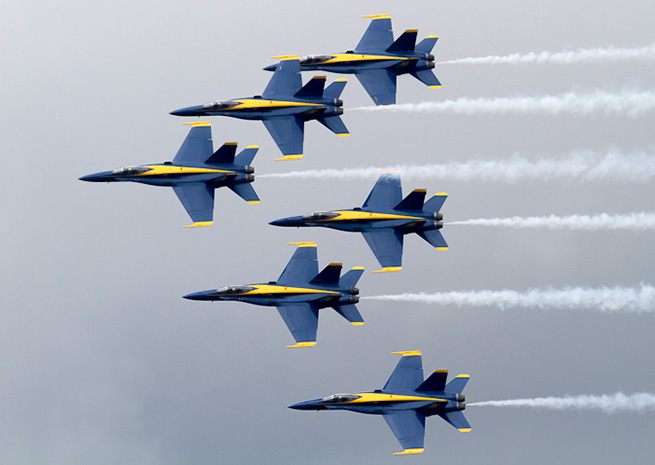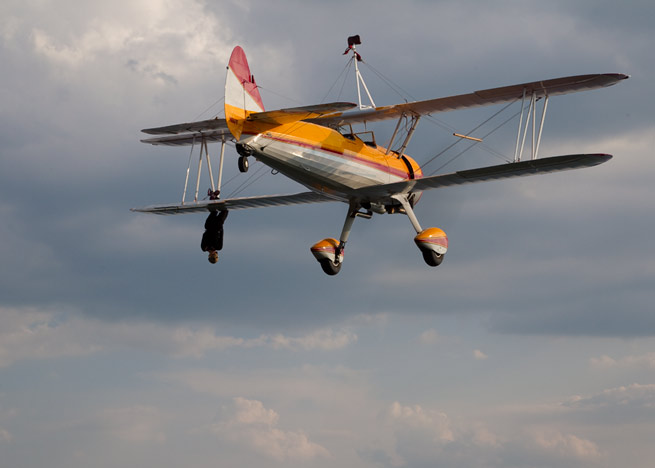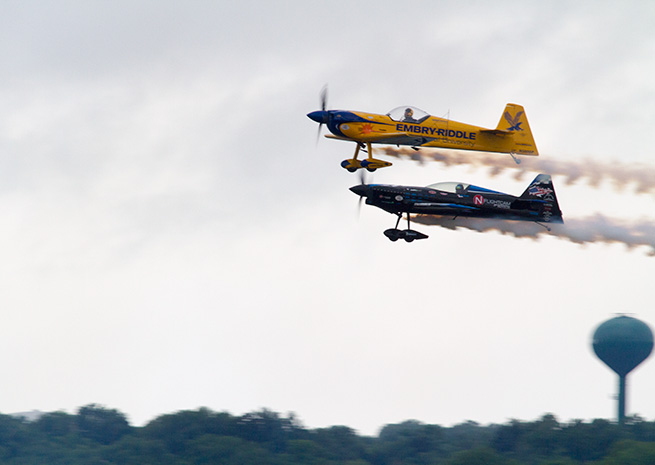
Airshows have endured many setbacks in their long U.S. history—but no single season has brought as much adversity as 2013.
First, the federal budget sequester grounded the Blue Angels and Thunderbirds as well as military demonstration aircraft for the entire season, and their pullout led organizers to cancel 63 shows, roughly 20 percent of the U.S. total. Since the scrubbed shows were among the season’s larger events, total airshow attendance and revenue fell disproportionately—by some estimates more than 50 percent.

Then, on June 22, veteran wing-walker Jane Wicker and pilot, Charlie Schwenker, were killed in a nightmarish accident in Dayton, Ohio. Video of the fiery crash was broadcast repeatedly on national newscasts and replayed hundreds of thousands of times on the Web. Wicker’s loss was felt keenly by fellow airshow performers, among whom she was a popular, respected, and encouraging personality.
Finally, near the end of the season, the FAA announced its intention to impose major fees for ATC services at aviation events large and small. The Experimental Aircraft Association was billed $450,000 for services at EAA AirVenture that used to be free, and EAA paid the bill while it challenges the FAA policy in federal court. Smaller events such as local airshows and aerobatic contests also face new FAA charges.
Any one of these developments would have been a major blow—but taken together they put into question the viability of future airshows and whether they can continue in their current form.
“Before 2012 the formula for airshow success was pretty straightforward,” said John Cudahy, president of the International Council of Air Shows in Leesburg, Va. “Get a jet team, and fill in with a diverse group of performers. If you’ve got the Rolling Stones, the warm-up band isn’t all that critical. But that formula doesn’t work without the main attraction.”
Lacking the draw of a military jet team, corporate sponsors pull out, and an airshow’s economic foundation collapses.
“If the military isn’t coming, you don’t get the sponsors, the revenue, or the concessions,” Cudahy said.
Major regional events such as the Navy’s “fleet week” celebrations in San Francisco and New York City, which traditionally draw more than 300,000 visitors each, weren’t held at all in 2013.
Looking ahead, it’s unclear when the Blue Angels and Thunderbirds, or popular single-aircraft demonstrations such as F-16s or A-10s will return. The deadlock surrounding the sequester appears more entrenched than ever, and military flight demonstration teams are a relatively small pawns in a far larger philosophical, economic, and political standoff.
“We make our case as forcefully as we can,” Cudahy said. “But the politics of the sequester are being played out at such a high level in government that it’s easy for airshows to get overlooked.”
But while the big U.S. airshows that depend on mass market appeal have suffered from the loss of military support, small shows—the ones that never had a chance of attracting a jet team—did relatively well in 2013.

Events like “Thunder Over Michigan,” “Wings Over Houston,” and the Commemorative Air Force’s annual “Airsho” in Midland, Texas, draw significant numbers of aviation enthusiasts who know and appreciate the largely historical aircraft featured at these events.
Also, civilian formation teams like the Black Diamond Jet Team, which use L-39 jets, Team AeroDynamix, which flies the RV series of kit airplanes, and the AeroShell Aerobatic Team, which consists of four T-6s, take on a new significance in the absence of military teams.
The high-profile deaths of Wicker and Schwenker created a public perception that airshow accidents were on the rise, so it may seem surprising that there were fewer fatal crashes in 2013 than any year a decade ago. There were 3.4 fatal accidents per year in the mid-2000s and fewer than two accidents a year in the last six years.
“People who come to airshows don’t expect to see accidents and they don’t want to see accidents,” Cudahy said. “They’re terrible for spectators, organizers, and performers alike.”
A scrapper
In response to new economic realities, airshow performers are altering their marketing, and their routines to appeal to a broader audience.
Greg Koontz, an aerobatic pilot, brings his “Alabama Boys” comedy routine to about 20 airshows annually. He’s also focusing on smaller airshows and has begun sharing the financial risk with some of them.
“If a two-day event gets rained out for one day, I won’t charge for the day we don’t fly,” he said. “The small shows are taking a risk, and I’m willing to share the risks along with the rewards.”
Koontz also teaches aerobatic flying to fly-in guests at his private airfield in northern Alabama, and he sells airplanes for American Champion. If airshow bookings decline, he devotes more time and effort to his other related business ventures.
“I’m a scrapper,” Koontz says. “I teach, run a bed and breakfast, do airshows, and sell airplanes. They’re all complementary.”
John Klatt, also a veteran aerobatic performer, regards the 2013 season as an anomaly and says airshows are too deeply ingrained in the American psyche to ever go away. Klatt is building a new aircraft that he plans to unveil at the International Council of Airshows convention in Las Vegas, Nevada, in December.
“Airshows are deeply embedded in our culture—and they’re very important for inspiring people and bringing them into aviation,” Klatt said. “I’m making a big investment in the future of airshows with my new airplane, and that’s the kind of thing it’s going to take to capture people’s imaginations.”
“Airshows have been part of the fabric of this country since the barnstorming days,” he said. “Airshows will evolve, but they’re not going away.”
Cudahy said he’s convinced that the airshow industry will adapt with a series of new offerings. They may be different venues, new aircraft, or altered economic models—but airshows will be forced to reinvent themselves, sequester or not.
“I’m optimistic that we can create quality entertainment that attracts large numbers of people with or without the jet teams. The capacity is there. I trust the creativity and the entrepreneurial spirit of the airshow industry.”



